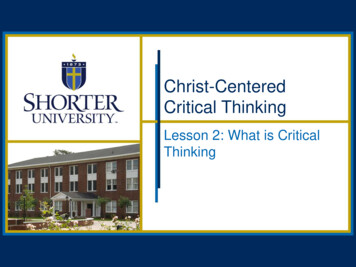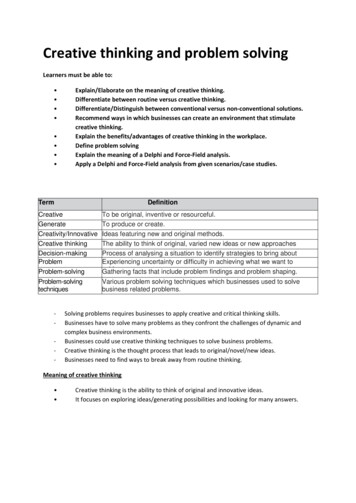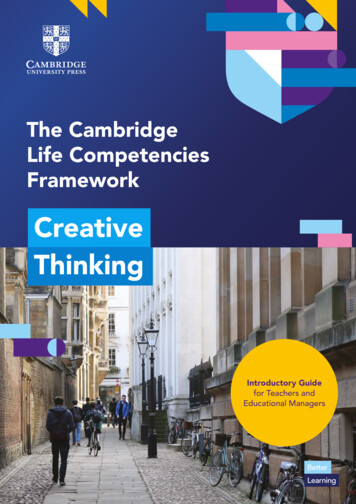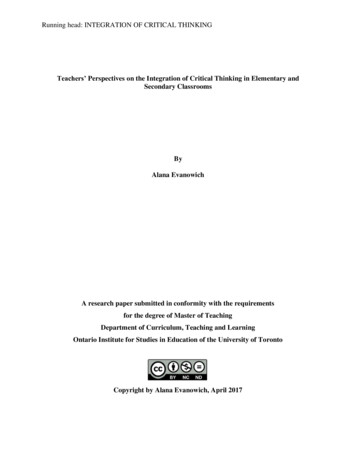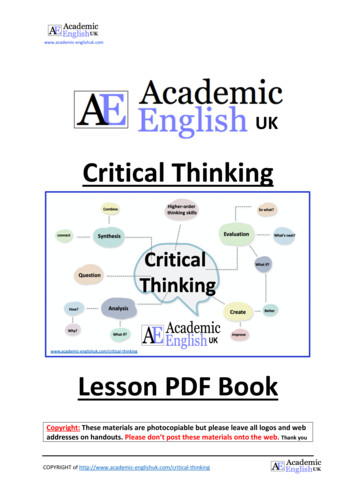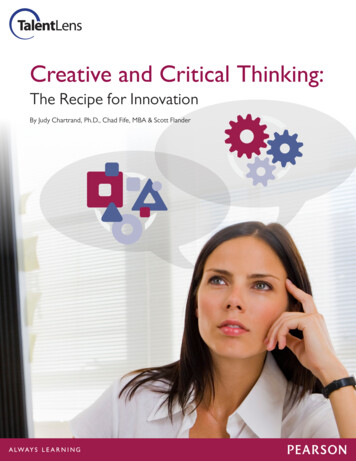
Transcription
Creative and Critical Thinking:The Recipe for InnovationBy Judy Chartrand, Ph.D., Chad Fife, MBA & Scott Flander
1It is hard to cook a dish properly if you’re missing a keyingredient. And yet businesses often wonder why they havetrouble getting innovation right. They know they need creativethinking– and lots of it. But they often lack the ability totransform their creative ideas into polished products forthe real world.Who can forget the Segway? Its inventor predicted that it would “be to the car whatthe car was to the horse and buggy.”His unbridled optimism blinded him to the fact thatno one really wanted or needed a motorized scooter to get around on city streets andsidewalks – and that 3,000 was far too high a price point for most people to even giveit a try.Or how about New Coke? Coca-Cola was certainly being innovative when it came upwith a new formulation that beat out Pepsi in taste tests. But company executives failedto recognize that the public would angrily resent any change to what it considered anational institution.The tech world in particular is littered with once-promising innovations that withered inthe harsh sunlight of the marketplace, such as the LaserDisc, the mini-disc, Palm devices,and Groupon.What all these examples demonstrate is that great ideas are not enough. Innovation –successful innovation – requires the application of critical thinking as well. This is theingredient that so many companies miss. What is required is a robust integration of bothcreative and critical thinking, a back-and-forth, iterative process that fosters maximumcreativity, while at the same time bringing a clear-eyed understanding of how an idea willplay out.Faced with today’s increased demand for innovation, many companies are searching fornew ways to encourage creative thinking. At the level of the organizational culture, theyare reinforcing the notion that it is OK if an idea fails – employees will not be penalizedfor thinking outside the box and striking out. Businesses are also adopting new techniquesfor brainstorming and synthesizing ideas. What many companies are less successful at,however, is bringing critical thinking into the picture at the right point in time.888.298.6227 TalentLens.comCopyright 2013 Pearson Education, Inc. or its affiliate(s). All rights reserved.
2How Critical Thinking WorksWhat is critical thinking? How can it be applied to the creative process without killing ideasbefore they are fully formed? How can teams of people – some better at creative thinking,some better at critical thinking – work together in a true collaboration?There are three essential elements of critical thinking:»» Recognizing assumptions. This involves separating fact from opinion. Too often, weaccept unsupported information as accurate because it reinforces our own beliefs, orbecause the speaker is particularly credible. Many innovations fail because companiesassume that their ideas will instantly be embraced by the public – ignoring warning signsthat might suggest otherwise.»» E valuating information. This involves stepping back and objectively sorting throughdifferent positions. Another reason innovations fail is that people often let emotions– their own or others’ – color their decisions. Or, people may go along with someoneelse’s position to avoid conflict. It is essential to systematically review and evaluateinformation in an unbiased manner.»» Drawing conclusions. This involves bringing diverse information together to arrive atconclusions that logically follow the evidence. Innovations will have a greater chance ofsuccess when people do not generalize beyond the evidence at hand, and are willing tochange their positions as the evidence changes.All three elements of critical thinking call for the ability to step back and take a hardlook at the problems an innovation may face. One of the common features in the postmortems of innovation failures is that executives were told of potential problems, but forone reason or another went ahead despite the concerns.When critical thinking is appliedto innovation, warning signs andred flags are thoroughly andcarefully considered – and in factare used to make the innovationbetter. Critical thinking is actuallyKeys toCRITICALTHINKINGRecognize AssumptionsE valuate ArgumentsD raw Conclusionsmade part of the creative process.888.298.6227 TalentLens.comCopyright 2013 Pearson Education, Inc. or its affiliate(s). All rights reserved.
3Bringing Creative Thinking and Critical Thinking TogetherThere is a common perception that creative thinking and critical thinking are incompatible– that creativity cannot flourish if it is subjected to a practical, hard-nosed approach. Butmany people, in a variety of professions, are able to seamlessly bring the two modes ofthinking together.An experienced product manager might spend a few weeks looking for next generationproduct ideas by searching material outside of her domain, attending a new conference,scanning on-line and print materials, talking to people, all in the vein of stimulating newideas and connections. At this this stage, the goal is to spark as many new new ideasas possible, unencumbered by a critical filter. The critical analysis comes later, as shechecks these new insights against the realities of the product market and corporatecapabilities. The product manager doesn’t apply creative and critical thinking at the samemoment, but rather switches between the two, generating and refining ideas with the goalof arriving at an innovative new product that can be successfully launched and sold.This process can be effectively replicated by innovationteams. While some people will excel equally at bothcreative and critical thinking, most tend to be stronger inone mode than another. Companies need both types ofpeople – as well as the ability to bring them together in acollaborative effort.Creative and Critical Thinking at Play in a Marketing DepartmentCreativityin action:Critical Thinkingin action:Requiresequal doses:»» Copywriterspersonalizing emailsubject lines that grabyour attention»» Product managersinterviewingcustomers to validateinterest»» Product creatorsspotting an unfilledneed that customerswill also pay for»» Bloggers connectingtheir product to ahot news item in anunexpected way»» SEO specialistsranking the topsearch terms buyersuse in their industry»» Leaders creating astrategic plan thatinspires a team»» Web designers tryingnew Buy buttons toimprove conversion»» Salespeople usingTwitter to learn moreabout a prospectbefore a meeting888.298.6227 TalentLens.com»» Managers matchingthe right message &channel to generate3x leads than inprevious quartersCopyright 2013 Pearson Education, Inc. or its affiliate(s). All rights reserved.
4Fostering Innovation & Team CollaborationGood ideas rely on equal doses of creative and critical thinking. The order doesn’t matteras much as how each mode of thinking plays a part to stretch or refine an idea. In somecases, members of an innovation team might decide on the need for a particular type ofinnovation, and then brainstorm how to fulfill that need. In other cases, team membersmight come up with ideas for innovation using an open canvas.Once an idea is formed, it must be given free rein to develop. Team members who aremore inclined to critical thinking must be willing to suspend judgment. No doubt they willsee serious flaws in ideas that come forth, but they must – at least for the time being – becareful about pointing them out. The first version of an idea is rarely bought to fruition.Ideas beget other ideas, and perhaps the 10th creative flash in a brainstorming session – orthe 30th – will be the one that leads to a successful innovation. If an early idea is stoppedin its tracks, the later, better ones may never see daylight.It is at this point, however, that innovation frequently falters. Although innovation teamsoften believe they are thoroughly vetting their ideas, too often they are so caught up in thepossibilities that they are not aware of how emotion or assumptions are getting in the way.They may take on faith certain suppositions – about how the public will receive the idea,for example – without a rigorous examination of the evidence.How Sony Missed Developing the iPodSometimes a lack of critical thinking can cause even aninnovation leader to fall behind. As a pioneer in portablemusic players with its Walkman line, Sony was well positionedto continue its industry leadership into the digital age. Instead,it ceded the game to Apple. A new book suggests that theproblem at Sony wasn’t too little creativity, but rather that theengineers let an emotion – arrogance – cloud their judgment.“Instead of listening to the market with humility, Sony’s engineers crammed theirbest technology into an MP3 player that was too cumbersome to use,” writesJake Breeden, in Tipping Sacred Cows: Kick the Bad Work Habits that Masqueradeas Virtues. “Instead of taking care of their customers’ need for simplicity,” he says,“they took care of their own engineers’ need for complexity. Engineers insideSony viewed the hard disk technology used in Apple’s iPod as beneath them, sothey went their own way. These innovators had brains full of ideas. Their problemwasn’t too few ideas. Their problem was too much narcissism.”888.298.6227 TalentLens.comCopyright 2013 Pearson Education, Inc. or its affiliate(s). All rights reserved.
5The goal of critical thinking in innovation is not to kill flawed ideas – though sometimesthat’s necessary – but to carefully evaluate an idea to see whether its flaws can beovercome, so that the idea can become stronger. If the critical thinking process issuccessful, good ideas will be kept alive and passed back to the creative thinkers formore work.During this phase, those who created the ideas must be willing to let go and allow theprocess to run its course. This is not always easy – unlike critical thinking, creativity ismore often bound up with one’s sense of self, and the associations made are moreintuitive and personal. It is difficult to see one’s ideas changed or evaluated without takingit personally. But the idea-creators must have faith in the process.Just as the product manager switches between creative and critical thinking, innovationsteams switch back and forth between the two modes, gradually refining their ideas. Insome cases they might reach the cold conclusion that the idea – though perhaps brilliant –is unlikely to become a commercially successful innovation. But if they do decide to moveforward, they can be confident they have paid attention to the red flags, and objectivelythought through the potential problems.Developing a Creative and CriticalThinking WorkforceIt has long been debated whether creativity can be taught, butthere is no doubt that it can be fostered within an organization,as noted above. By contrast, critical thinking is less abstract,and many companies have added classes and workshops thatteach employees how to better question their own and others’assumptions, evaluate arguments, and draw sound conclusions.In fact, critical-thinking training – for all members of aninnovation team – is essential to understanding how theprocess of bringing creative and critical thinking togetherworks. Before the first brainstorming session even begins, both the more creative andthe more critical thinkers need to be fully aware of the iterative nature of the process.With this understanding, the critical thinkers can hold back their judgments during thecreative phases of the process, and join in the idea generation. At the same time, ifcreative thinkers have faith in the process, they will be more likely to embrace an objectiveevaluation of their ideas, one that puts emotion and ego aside. What emerges is a genuinecollaboration that uses creative and critical thinking as twin engines to power innovation.Another step companies can take is to ensure that the innovation teams are not confinedto organizational silos. Both creative and critical thinking flourish best when there ismaximum diversity. A broad knowledge pool and wide ranging perspectives provide richsoil for innovation. Nothing stifles innovation like the sameness of thought.888.298.6227 TalentLens.comCopyright 2013 Pearson Education, Inc. or its affiliate(s). All rights reserved.
6Innovation isn’t magic. It is simply the outcome of two of the most basic humancharacteristics – the ability to dream, and the ability to reason. Successful innovationoccurs when those two work side by side.A Checklist for Creating an Innovation Funnel5 Ways to Enhance Creativity (When Creating Something New) A ctively support creativity (e.g., form innovation teams) and rewardcreativity so that employees are positively motivated to try. B ring together staff who have different backgrounds anddifferent areas of expertise; encourage socialization (e.g., havelunch together) and opportunities for cross-fertilizing ideas. C reate opportunities for incubation – quiet time or downtime when ideas can percolate. S timulate thinking by exposing staff to new ideas(schedule expert presentations and discussions, watch Ted talks,create walls of inspiration or innovation). S uspend judgment during idea generation – focus more on quantitythan quality at this stage.5 Ways to Enhance Critical Thinking (When Evaluating for Quality) S top and think to determine what’s going on and whatyou are trying to accomplish; set direction and get clearon your goal. R ecognize assumptions and distinguish fact fromopinion to make sure you’re solving the right problem(or focusing on the right issue). O bjectively evaluate information and arguments(e.g., ask yourself if it’s needed – or is it relevant & accurate?). D raw conclusions that fit the evidence at hand(does your decision logically follow the information and achieve your goals?). Plan the steps and resources needed to implement any decisions.Great Result888.298.6227 TalentLens.comCopyright 2013 Pearson Education, Inc. or its affiliate(s). All rights reserved.
7PearsonTalentLens, a Pearson business, publishes scientific assessments that are usedglobally to hire and develop the 21st century workforce. Our instrumentsmeasure critical thinking, problem solving, and a range of job skills to deliverdata-driven insights that inform and clarify an organization’s human capitaldecisions. Learn more at TalentLens.com or call 888.298.6227.We are part of the Assessment & Information group within Pearson Education.Pearson’s other primary businesses include the Financial Times Group and thePenguin Group.Learn more and create your online testing account atwww.TalentLens.com888.298.6227 TalentLens.comCopyright 2013 Pearson Education, Inc. or its affiliate(s). All rights reserved.
creative thinkers have faith in the process, they will be more likely to embrace an objective evaluation of their ideas, one that puts emotion and ego aside. What emerges is a genuine collaboration that uses creative a



